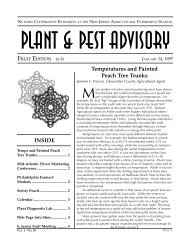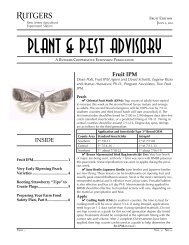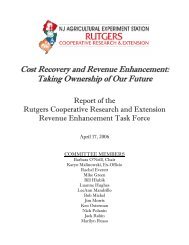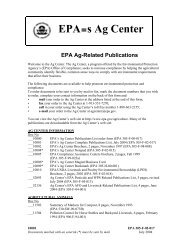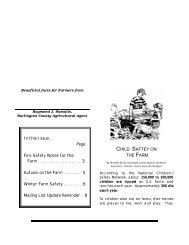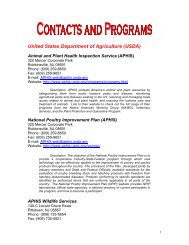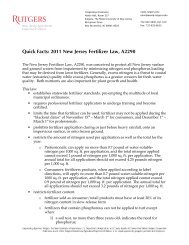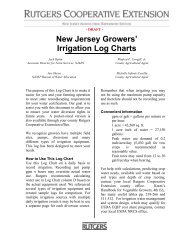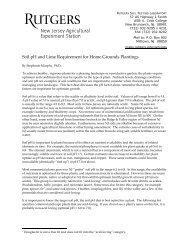INSIDE Bacterial Leaf Scorch of Oak - Rutgers New Jersey ...
INSIDE Bacterial Leaf Scorch of Oak - Rutgers New Jersey ...
INSIDE Bacterial Leaf Scorch of Oak - Rutgers New Jersey ...
Create successful ePaper yourself
Turn your PDF publications into a flip-book with our unique Google optimized e-Paper software.
BLS from page 1<br />
ease; adults remain infective for the<br />
remainder <strong>of</strong> their life, nymphs are<br />
infective only until their next molt.<br />
Diagnosis<br />
Symptoms <strong>of</strong> BLS are very similar<br />
to those caused by agents such as<br />
moisture stress and excessive salt. It<br />
is not surprising, therefore, that the<br />
disease is frequently misdiagnosed.<br />
To diagnose this disease, submit<br />
a small branch specimen (pencilwidth<br />
in diameter), with scorched<br />
leaves attached, to the <strong>Rutgers</strong> Plant<br />
Diagnostic Laboratory for analysis;<br />
do not wrap the sample in plastic.<br />
The laboratory will identify<br />
BLS through the use <strong>of</strong> a selective<br />
antibody (ELISA) technique. Proper<br />
sampling is necessary for an accurate<br />
diagnosis; the best samples have<br />
leaves that are symptomatic for the disease.<br />
For more information on mailing<br />
and fees, see the following link:<br />
http://njaes.rutgers.edu/plantdiagnosticlab/<br />
or see Turf Disease article on page 4<br />
for further contact information.<br />
Management<br />
Care-takers <strong>of</strong> the <strong>New</strong> <strong>Jersey</strong><br />
urban forest should look for<br />
the canopy thinning and marginal<br />
scorch characteristic <strong>of</strong> BLS from<br />
now through mid-October. Since<br />
there is no cure for this disease,<br />
proper management strategy includes<br />
the maintenance <strong>of</strong> tree vigor<br />
for as long as possible. If possible,<br />
water affected trees during times <strong>of</strong><br />
water stress to reduce the debilitating<br />
affects <strong>of</strong> this disease. In addition,<br />
other diseases, insects, and<br />
environmental stresses (including<br />
drought) enhance the development<br />
<strong>of</strong> BLS. Branches and infected trees<br />
in a severe state <strong>of</strong> decline should be<br />
routinely removed as they are potential<br />
hazards. Expensive tree injections<br />
reduce symptom development,<br />
but do not cure the disease and must<br />
be repeated. In areas known to be<br />
affected by this disease, replace affected<br />
trees with species that are not<br />
known hosts <strong>of</strong> the bacterium. o<br />
Landscape IPM Pest Notes<br />
Steven K. Rettke, Ornamental IPM Program Associate<br />
4 PRAYING MANTIDS: Are They Valuable Landscape Predators?<br />
Contrary to popular belief, these well known predators do not have a significant<br />
impact towards the suppression <strong>of</strong> any key landscape pests. Praying<br />
mantids are generalist predators and should not be promoted to clients<br />
as viable control agents in the landscape or garden. They are indiscriminate<br />
feeders and will consume both pest and beneficial insects, including<br />
honeybees, ladybeetles, butterflies, and lacewings. Furthermore, they are<br />
cannibalistic and highly territorial. As these insects molt/grow and develop<br />
during the season, it is rare for them to maintain their numbers at densities<br />
high enough to contribute to major biological controls in the landscape.<br />
An old urban myth, apparently sometimes promoted by elementary<br />
school children, is that state laws protect praying mantids. There have<br />
never been any <strong>of</strong>ficial state laws protecting this insect anywhere in the<br />
country. However, the destruction <strong>of</strong> this insect is not being endorsed<br />
when observed. Its only crime is that they have incorrectly been awarded<br />
high status as valuable predators.<br />
4 ANTS & HONEYDEW PRODUCERS vs. PREDATORS: Various pests<br />
such as aphids, s<strong>of</strong>t scales, mealybugs, and whiteflies are plant feeders that<br />
insert their piercing-sucking mouthparts into vascular tissue (phloem) to remove<br />
plant sap from leaves or stems. Since phloem sap is not nutrient rich<br />
in proteins, plant pests must withdraw large quantities to maintain growth<br />
and reproduction. As a result, to avoid blowing-up into “Macy’s Thanksgiving<br />
Day Balloon Floats” these insects must also expel copious amounts<br />
<strong>of</strong> unwanted waste called honeydew. The predigested honeydew still contains<br />
a lot <strong>of</strong> sugary carbohydrates and is valued by ants, wasps, bees and<br />
other vespids as a food source. The honeydew is <strong>of</strong>ten easily observed as a<br />
clear, shiny and sticky material on foliage. The honeydew usually darkens<br />
over time as a black sooty mold fungus grows on the liquid droppings.<br />
Numerous predators and parasitoids including ladybeetles, lacewings,<br />
flower flies and wasp parasites typically attack and consume honeydewproducing<br />
pests. Carpenter ants and other colony ant species have waged<br />
vicious wars for “eons” against predators <strong>of</strong> honeydew producers. Certain<br />
ant species will expend a lot <strong>of</strong> energy and effort to protect honeydew producers<br />
and prevent effective biological control. As a result, to help restore<br />
the predator vs. prey balance in the landscape, it may be necessary for<br />
the pest manager to intervene and seek out ant colony locations to apply<br />
controls.<br />
4 SYMPTOMS vs. SIGNS: Occasionally plant diagnosticians will<br />
mistakenly use symptoms and signs interchangeably when describing plant<br />
problems. It is important to distinguish the difference in meaning when<br />
describing each term. Being consistent when communicating plant diagnostics<br />
will help reduce confusing an already complicated process.<br />
Symptoms can be defined as the abnormal appearance <strong>of</strong> a plant after<br />
successful pest attack (e.g., stippling, defoliation, skeletonization, notching,<br />
chlorosis, necrosis, etc.). A common error arborists sometimes make<br />
is classifying woodborer exit holes as signs. In actuality it is proper to call<br />
them symptoms.<br />
Alternatively, signs can be defined as the actual presence <strong>of</strong> the pest<br />
(the causal agent) or pest related byproducts (e.g., active insects, mites, or<br />
cast skins, eggs, webbing, honeydew, sooty mold, fruiting bodies, mycelium,<br />
etc.). For example, since signs are observed causal agents, it would<br />
be correct to call tree damaging girdling roots as signs.<br />
See Ipm peSt noteS on page 3<br />
Page 2 Vol. 3 No. 2



